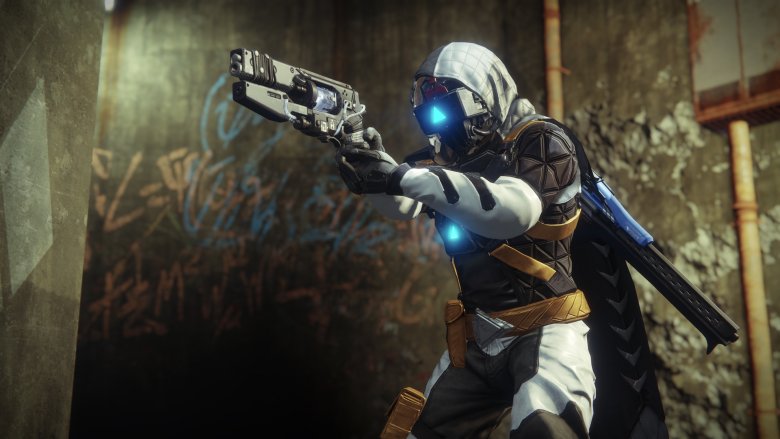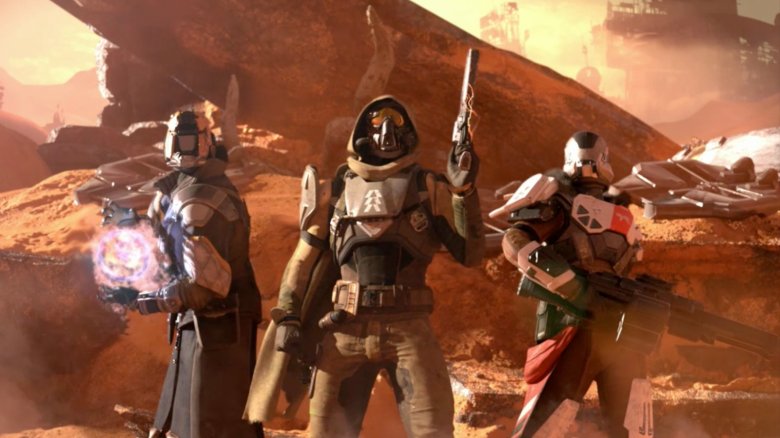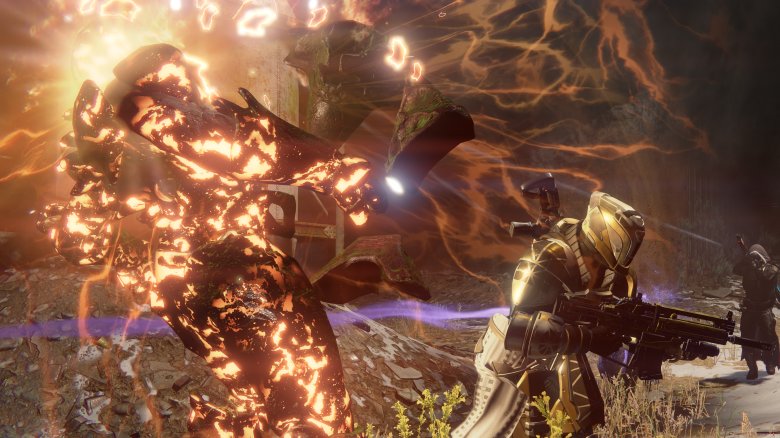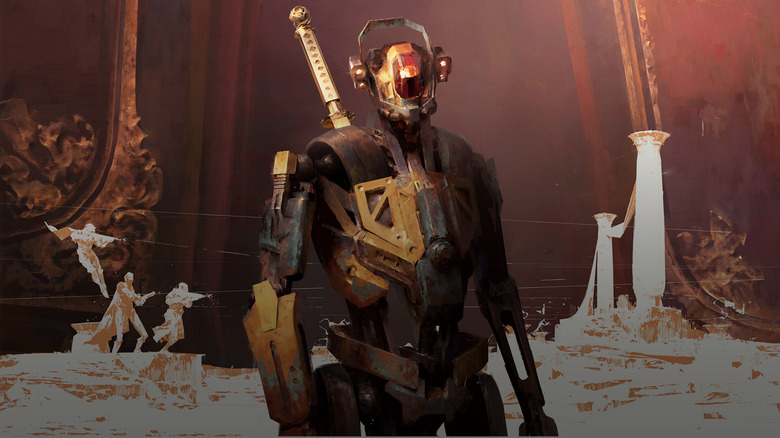Destiny: The Untold Truth Of Bungie's Halo Follow-Up
Bungie has been around for close to thirty years now, and in that time, they've produced some of the most beloved and famous games ever. From bringing first-person shooters to the Mac with Marathon, to redefining the real-time tactics genre with Myth, to leading the industry with Halo, the team at Bungie has proven its talents across a variety of genres and platforms. The developer's attention to detail and sense for balance are peerless. Bungie is a leader in a sea of copycats.
Currently, Bungie is entirely focused on one franchise — Destiny — a mixture of the shooter, MMO, and RPG genres. The first game in the franchise debuted in 2014 after a long development cycle, and the sequel, Destiny 2, arrived in 2017. But both of these mammoth titles, and indeed the franchise as a whole, have undergone major changes and shifts in direction. Competing philosophies on the very nature of the game have led to staff shakeups, business changes, and years of work tossed aside.
No matter how many hours you've put into Destiny, here are some facts behind the franchise you may not have known. Cryptarch not required.
Destiny began when Bungie passed off the Halo torch
The blockbuster finale to the biggest gaming trilogy of the 2000s, Halo 3, released in September of 2007. Once again racking up both strong reviews and major sales, the relationship between developer Bungie and parent company Microsoft appeared to be flourishing to the outside world. That's why it was such a shock when, barely a month later, Bungie and Microsoft announced they were parting ways. While Microsoft would retain the IP rights to Halo, Bungie would spin back off into an independent company. The exact reasons for this have never been announced publicly, but it seems likely that Bungie wanted complete creative freedom to do whatever they wanted. In other words, they didn't want to become a factory for Halo games.
So, what did they do with their newfound freedom? They immediately... made a Halo game. Specifically, they made Halo 3: ODST. And then, they made yet another Halo game, Halo: Reach. Again, the exact reason why Bungie agreed to go back to Microsoft after leaving them has never been revealed publicly. Maybe they just needed to get some cash in the door now that they couldn't depend on Microsoft's infinite reserves. Whatever the reason, Reach did at last mark the end of Bungie's work on the franchise.
Somewhere around this same time, Bungie started development on a brand-new game, finally delivering on the promise of what an independent developer could accomplish. With their reputation still sparkling, money in the bank, and one of the best teams in the business, Bungie was free to reach for the stars.
Bungie wanted to make their Star Wars. And Lord of the Rings.
After decades of success, Bungie didn't lack for confidence as they began their new venture. Halo had dominated the gaming conversation for nearly ten years, and the intellectual property had spun off into books, comic books, and very nearly a Peter Jackson film. Bungie knew they had the ability to make pop-cultural landmarks, and they had no intention of going smaller as they set off into independent status. Rather, they wanted to go big. Very, very big.
In a 2013 interview, Bungie COO Pete Parsons declared they wanted their new game, called Destiny, to impact audiences the same way Star Wars or The Lord of the Rings had. In other words, they wanted Destiny to have the massive scope and depth of world-building needed to bring a fictional universe to vibrant life, so much so that millions of people would visit and never want to leave. Those are some huge ambitions, but if any studio had the pedigree and the talent to go for it, it was Bungie.
But even Bungie would need a partner on a venture like this. In 2010, they shocked the industry by announcing a ten-year publishing deal with Activision, including a reported $500 million investment. Bungie later clarified that the investment was for the entire franchise over the whole ten years, not the development budget for a single game. Nevertheless, Bungie now had a publishing deal in place, a colossal franchise-spanning budget, and dreams of grandeur. There was nothing to stop them now.
Everything changed half-way through development
Bungie finally revealed Destiny to the world in February of 2013. And sure enough, bold pronouncements were made: of multiple planets to explore, of a seamless online experience, and of a rich narrative to enjoy. With persistent progression and the ability to easily join up with friends across open worlds, Destiny hoped to feel as close to a living, breathing science-fiction story as possible.
But there was a major problem: the science-fiction story itself. According to a lengthy investigation by Kotaku, long-time Bungie writer Joe Staten and his team had crafted a sprawling space opera epic of which they were quite proud. But in the summer of 2013, just months after the company had announced the game and its story, Bungie's senior management decided to jettison most of the narrative work that had already been done and start again from scratch. Kotaku's sources differ on the reasons why, but it appears that the story may simply not have been all that good. At the same time, Destiny was supposed to allow players unlimited freedom to go where they wished, when they wished; an authored, linear experience wouldn't have allowed them to do this.
This massive change threw the development, already difficult to corral, into chaos. Bits and pieces of new story had to be crammed into various corners of the Destiny universe, while still allowing the player to go anywhere at any time. With his hard work in shambles, Staten left the company, and not on good terms. Unfortunately, he wouldn't be the last.
Destiny caused a lot of casualties at Bungie
With a development process that began in 2010, through the launch of a live-service game, and into a sequel released in 2017, Destiny has been an occupation for hundreds of individual developers for years. So it's natural that, over that long timespan, some employees have moved on. But even with that in mind, an unusual number of developers have been leaving the project. Some of those exits have been very public, and very hostile. However popular the franchise might be, it clearly has been a difficult work environment — and it's taken its toll.
Perhaps the most famous Bungie employee to leave, other than aforementioned writer Joe Staten, was long-time composer Marty O'Donnell. The man who had defined the sound of Halo was forced to watch Activision remove his music from the E3 2013 trailer. Later, after apparently becoming demoralized by Activision's growing influence over the game, his work output deteriorated. In the end, he was fired from Bungie. He didn't take it too well and filed two lawsuits, both of which ended in his favor.
O'Donnell did mention that part of the reason he felt so demoralized towards the end was the sheer number of team members — veterans he'd worked with for years — that left or were pushed out during Destiny's development. Combined with other key departures since, it appears that there aren't too many old-school Bungie employees left. While the name of the company is the same, it's a different Bungie making Destiny than made Halo.
The game had all sorts of issues on release
After at least four years in development, and all the trials and tribulations along the way, Destiny finally released for both seventh- and eighth-generation consoles on September 9, 2014. This most ambitious project of one of gaming's best developers prepared for a flood of acclaim. Instead, its first major review came in the form of Polygon's now-infamous 6/10. On Metacritic, Destiny landed at a disappointing 76, low enough to prevent Bungie from receiving a $2.5 million good-score bonus from Activision.
Bungie's problems didn't stop with their reviews, however. Gamers quickly complained about the confusing in-game reward system, in which an enemy might drop a purple item (purple indicating the best possible tier of reward), only to have it later be revealed as a low blue-tier item. Later, players found that the best way to grind for new gear was to stand in front of a cave where enemies spawned, and simply shoot them as they arrived (referred to as the "Loot Cave"). Soon, it seemed like more players were shooting into the bottomless abyss of the Loot Cave than, you know, playing the game.
Plus there were the Light Levels, which nobody really understood. And a lot of fans were left to wonder what happened to the sweeping story that was promised: the only answer they received was, "I don't even have time to explain why I don't have time to explain." All told, this was a much rougher landing than Bungie had been prepared for.
Still, Destiny was the best-selling launch of a new game IP, ever. So it wasn't all bad.
The original business plan went out the airlock
Bungie certainly had a plan for Destiny beyond just the launch itself. Two DLC packs, featuring new story and gameplay content, were announced alongside the release. "We're going to continuously update the game from now until the end of time," Bungie's Director of Production Jonty Barnes said. These first two packs, called The Dark Below and House of Wolves, were relatively small affairs priced at $20 each. This appears to have been the original live-service business model for the game: continue to produce small expansions to increase the game a little at a time. However, after House of Wolves, this strategy disappeared.
The next DLC was a much larger content addition that Bungie called an expansion, named The Taken King. It released a full year after the original game, and cost $40. Clearly, the drip-feed of small content drops had stopped. Afterwards, Bungie introduced microtransactions as well. The monetization of Destiny was evolving in real-time. A final DLC pack, Rise of Iron, dropped two years after the original game and marked the end of major content additions. So much for "until the end of time."
Barnes had also promised, "We always wanted to build a new universe but keep building upon it, rather than to do a complete and utter restart periodically." Naturally, in 2017, Bungie announced Destiny 2: a complete and utter restart. (More on that in a bit.)
Ghost changed his voice
Despite the relative lack of story in the final game, Destiny still had one character who spoke to the player constantly: a robotic companion named Ghost. Voiced by actor Peter Dinklage, Ghost was more or less the personality of the entire experience. Dinklage himself is an Emmy-winning actor capable of fantastic performances. And yet, for whatever reason, his role as Ghost came out ... rather poorly. Most famously, for all the wrong reasons, was his delivery of a truly bizarre line: "That wizard came from the Moon."
Less than a year later, Dinklage was replaced as the voice of Ghost by veteran video game voice actor Nolan North. Officially, this was because Dinklage had too many other commitments to continue performing the role. Unofficially, this may well have been a tacit admission that Dinklage had simply phoned this one in. In the end, it's not clear that North's voiceover was actually all that much different.
One gun became a lightning rod of Destiny's critics (and fans)
Part of Destiny's appeal is its loot reward system: while there are any number of weapons and items to be used in the game, they're categorized from Basic (common items with unremarkable effects) through various levels of rarity, culminating in Exotic (extremely uncommon items with fantastic abilities). Of all the Exotics in the game, one in particular became a sensation: Gjallarhorn, a rocket launcher that could both auto-target the enemy and deal an enormous amount of damage. Plus, it looked cool.
On paper, Gjallarhorn appeared to be a perfect example of Destiny's overall design. Players knew the weapon was out there to be achieved, if only they participated in activities, i.e., played the game. For their efforts, the weapon would reward them with a fantastic new tool for taking on the toughest challenges Destiny could provide. Time spent, progression achieved.
The problem? Gjallarhorn, and for that matter, all items in the game, had a certain percentage chance to 'drop' at any time loot was to be awarded to the player. Which meant that it was entirely random who would get the weapon, or when. A very lucky player might score a Gjallarhorn on day one, whereas a veteran of hundreds of hours might never see it. This all led to criticism that Destiny was prioritizing blind luck over time commitment or skill. Which, all things considered, was not a great look for the game.
Despite its flaws, Destiny earned an enormous following
So, Destiny suffered from a lot of design issues at launch, a wonky reward system, casting problems, and internal staff churn. Reviews came in lower than expected, and all around the hype for the game ran into a brick wall. The result?
Massive, massive success.
Besides being the best-selling new IP in gaming history, Destiny was talked about endlessly in publication after publication. The game featured some of the best gunplay around, and whatever its overall issues, the moment-to-moment actions just felt great, especially with friends. Destiny wound up selling over 25 million copies, and garnered a devoted and consistent following on streaming site Twitch. It had an enormous impact on other games in development, and indeed, some new games from rival studios seem like they were created to be direct challengers. For all the chaos of its development, Bungie had done it again: crafted a game that seemed like just another shooter, and elevated it into an experience like no other.
Destiny 2 was meant to be a clean-slate
For all their success, however, Bungie knew that Destiny was far short of perfect. Many of the issues couldn't be fixed in a simple patch, and even well-received content additions like The Taken King couldn't change the foundations of the core experience. In order to take everything that worked in Destiny and carve out everything that didn't, Bungie would have to start all over. And so, despite Barnes' claim that, "We always wanted to build a new universe but keep building upon it, rather than to do a complete and utter restart periodically," Bungie eventually chose to do exactly that.
Destiny 2 would not preserve any of the hard-earned progression players had spent hundreds of hours earning. While a character from the first game could be imported into the second – under certain conditions, anyway – none of their gear or level-ups would follow. In this way, new players would be able to come in without feeling outmatched by veterans, and Destiny 2's new progression system could begin from scratch.
The sequel has faded in a way the original never did
In theory, Destiny 2 should have been a perfect version of the original game, with all of its strengths and none of its weaknesses. And yet, gaming influencers who made their name playing the first Destiny have been abandoning the second in droves. Once a staple of Twitch's top-streamed list, Destiny games find themselves falling farther and farther down. Despite much better reviews this time around, the community had not responded in the same way.
Everybody has an opinion on what the problem is, and why there was such a discrepancy between the initial goodwill and the later disillusionment. In general, it appears that the title's endgame content is simply not up to par with where the original Destiny concluded, and that the progression system had been re-tuned to reward casual, instead of hardcore, players. In other words, Bungie's reset created a simpler, less interesting, and less exciting all-around game, even if it was more accessible.
The team at Bungie are trying hard to address fans' concerns and build a better Destiny 2 on the fly, much as they did with the first Destiny. It remains one of the biggest games on the marketplace, and Bungie remains one of the industry's titans. Destiny was always an ambitious project, and in many ways, that ambition was brought to life with exquisite craftsmanship and a willingness to adjust course when needed. And Bungie isn't even close to the end of their ten-year contract with Activision. The IP still has a lot of loot left in it. And if anyone knows how to find the franchise's, well, destiny, it's Bungie.
The comeback story of Destiny 2
Both Bungie and the Destiny franchise are nothing if not resilient. Destiny launched with a host of issues, but Bungie managed to board up a lot of holes and bail the ship out. When Destiny 2 arrived, many players were surprised to see that it took several steps backward. Those fans made their voices loudly heard, and now — years after Destiny 2 first launched — Bungie appears to have saved itself and its game yet again.
The comeback story of Destiny 2 started with 2018's Warmind expansion, which gave players more endgame loot to chase and more activities to grind. And it continued with the game's next major expansion, Forsaken, which added a whole new campaign story, made drastic changes to the game's weapons systems, and introduced dungeons as an endgame activity.
And then there's the topic of Bungie's independence, which has made a lot of fans very happy.
Bungie announced in early 2019 that its publishing agreement with Activision was coming to an end, and we've already seen what that means for Destiny 2. Platform-exclusive content will no longer exist. Cross-save will arrive simultaneously with Destiny 2's next expansion, Shadowkeep. And Destiny 2 will make its way to two new platforms: Steam on PC, and Google Stadia, a new game streaming service launching in fall 2019.
Destiny 2 is reportedly back to having over a million active players per day, and that's very good news for the future.




